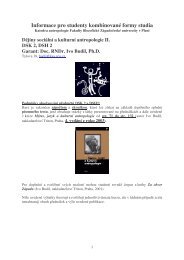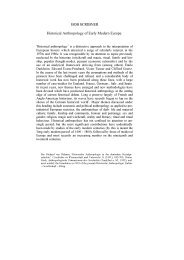The Revival of Narrative: Reflections on a New Old History ...
The Revival of Narrative: Reflections on a New Old History ...
The Revival of Narrative: Reflections on a New Old History ...
Create successful ePaper yourself
Turn your PDF publications into a flip-book with our unique Google optimized e-Paper software.
THE REVIVAL OF NARRATIVE<str<strong>on</strong>g>of</str<strong>on</strong>g> the past. Analysis certainly remains the essential part <str<strong>on</strong>g>of</str<strong>on</strong>g> theenterprise, which is based <strong>on</strong> an anthropological interpretati<strong>on</strong> <str<strong>on</strong>g>of</str<strong>on</strong>g>culture that claims to be both systematic and scientific. But thiscannot c<strong>on</strong>ceal the role <str<strong>on</strong>g>of</str<strong>on</strong>g> the study <str<strong>on</strong>g>of</str<strong>on</strong>g> mentaliti in the revival <str<strong>on</strong>g>of</str<strong>on</strong>g> n<strong>on</strong>analyticalmodes <str<strong>on</strong>g>of</str<strong>on</strong>g> writing history, <str<strong>on</strong>g>of</str<strong>on</strong>g> which story-telling is <strong>on</strong>e.Of course narrative is not the <strong>on</strong>ly manner <str<strong>on</strong>g>of</str<strong>on</strong>g> writing the history <str<strong>on</strong>g>of</str<strong>on</strong>g>mentalite which has been made possible by disillusi<strong>on</strong>ment withstructural analysis. Take, for example, that most brilliant rec<strong>on</strong>structi<strong>on</strong><str<strong>on</strong>g>of</str<strong>on</strong>g> a vanished mind-set, Peter Brown's evocati<strong>on</strong> <str<strong>on</strong>g>of</str<strong>on</strong>g> the world<str<strong>on</strong>g>of</str<strong>on</strong>g> late antiquity.20 It ignores the usual clear analytical categories -populati<strong>on</strong>, ec<strong>on</strong>omics, social structure, political system, culture, andso <strong>on</strong>. Instead Brown builds up a portrait <str<strong>on</strong>g>of</str<strong>on</strong>g> an age rather in themanner <str<strong>on</strong>g>of</str<strong>on</strong>g> a post-Impressi<strong>on</strong>ist artist, daubing in rough blotches <str<strong>on</strong>g>of</str<strong>on</strong>g>colour here and there which, if <strong>on</strong>e stands far enough back, create astunning visi<strong>on</strong> <str<strong>on</strong>g>of</str<strong>on</strong>g> reality, but which, if examined up close, dissolveinto a meaningless blur. <str<strong>on</strong>g>The</str<strong>on</strong>g> deliberate vagueness, the pictorial approach,the intimate juxtapositi<strong>on</strong> <str<strong>on</strong>g>of</str<strong>on</strong>g> history, literature, religi<strong>on</strong>and art, the c<strong>on</strong>cern for what was going <strong>on</strong> inside people's heads, areall characteristic <str<strong>on</strong>g>of</str<strong>on</strong>g> a fresh way <str<strong>on</strong>g>of</str<strong>on</strong>g> looking at history. <str<strong>on</strong>g>The</str<strong>on</strong>g> method isnot narrative but rather apointilliste way <str<strong>on</strong>g>of</str<strong>on</strong>g>writing history. But it toohas been stimulated by the new interest in mentalite' and made possibleby the decline <str<strong>on</strong>g>of</str<strong>on</strong>g> the analytical and structural approach which hasbeen so dominant for the last thirty years.<str<strong>on</strong>g>The</str<strong>on</strong>g>re has even been a revival <str<strong>on</strong>g>of</str<strong>on</strong>g> the narrati<strong>on</strong> <str<strong>on</strong>g>of</str<strong>on</strong>g> a single event.Georges Duby has dared to do what a few years ago would have beenunthinkable. He has devoted a book to the account <str<strong>on</strong>g>of</str<strong>on</strong>g> a single battle -Bouvines - and through it has illuminated the main characteristics<str<strong>on</strong>g>of</str<strong>on</strong>g> early thirteenth-century French feudal s~ciety.~' Carlo Ginzburghas given us a minute account <str<strong>on</strong>g>of</str<strong>on</strong>g> the cosmology <str<strong>on</strong>g>of</str<strong>on</strong>g> an obscure andhumble early sixteenth-century north Italian miller, and by it hassought to dem<strong>on</strong>strate the intellectual and psychological disturbanceat the popular level caused by the seepage downward <str<strong>on</strong>g>of</str<strong>on</strong>g> Reformati<strong>on</strong>ideas.22 Emmanuel Le Roy Ladurie has painted a unique and unforgettablepicture <str<strong>on</strong>g>of</str<strong>on</strong>g> life and death, work and sex, religi<strong>on</strong> andcustom in an early fourteenth-century village in the pyre nee^.^^M<strong>on</strong>taillou is significant in two respects: first, because it has become<strong>on</strong>e <str<strong>on</strong>g>of</str<strong>on</strong>g> the greatest historical best-sellers <str<strong>on</strong>g>of</str<strong>on</strong>g> the twentieth century inFrance; and sec<strong>on</strong>dly, because it does not tell a straightforward story-there is no story -but rambles around inside people's heads. It is20 P. Brown, <str<strong>on</strong>g>The</str<strong>on</strong>g> World <str<strong>on</strong>g>of</str<strong>on</strong>g> Late Antiquity from Marcus Aurelius to Muhammad(L<strong>on</strong>d<strong>on</strong>, 197 I).21 G. Duby, Le dimanche de Bouvines, 27 juillet 1214 (Paris, 1973).22 C. Ginzburg, I1 formaggio e i vermi (Turin, I 976).23 E. Le Roy Ladurie, M<strong>on</strong>taillou, village occitan de 1294 a 2324 (Paris, 1976),trans. B. Bray as M<strong>on</strong>taillou: Cathars and Catholics in a French Villaae, 1294-1724-. ,,(L<strong>on</strong>d<strong>on</strong>, I 978).I7







